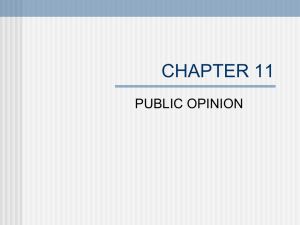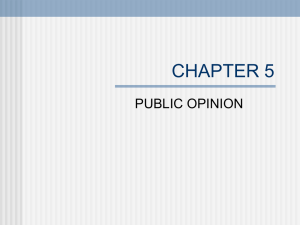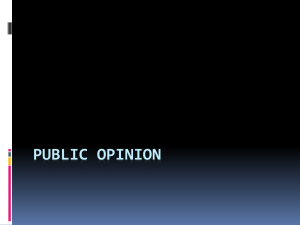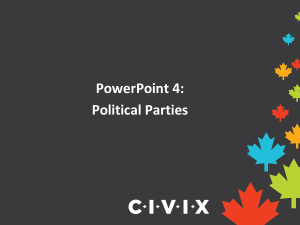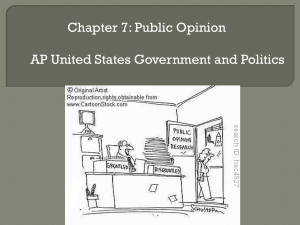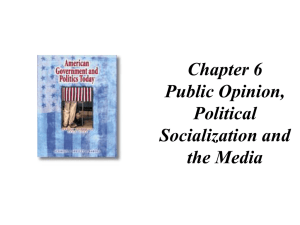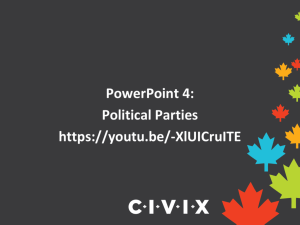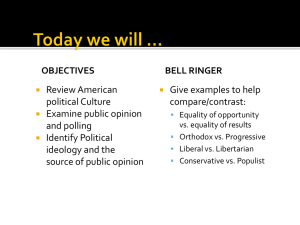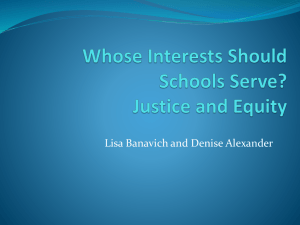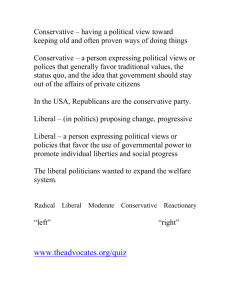Chapter 5 focus and outline
advertisement
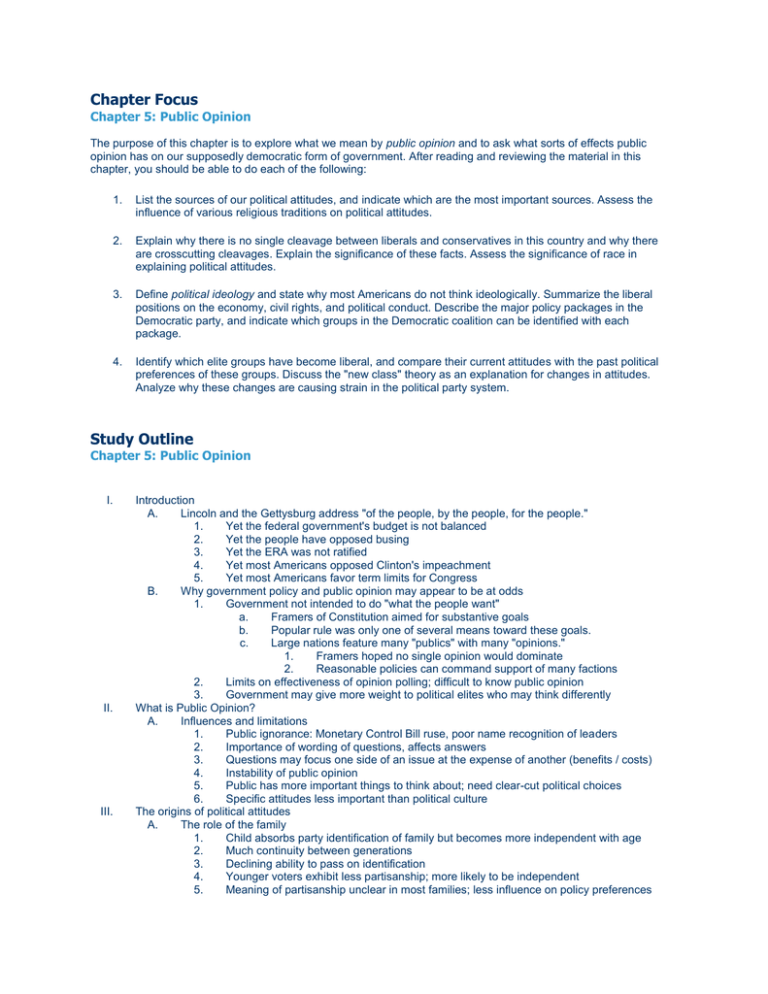
Chapter Focus Chapter 5: Public Opinion The purpose of this chapter is to explore what we mean by public opinion and to ask what sorts of effects public opinion has on our supposedly democratic form of government. After reading and reviewing the material in this chapter, you should be able to do each of the following: 1. List the sources of our political attitudes, and indicate which are the most important sources. Assess the influence of various religious traditions on political attitudes. 2. Explain why there is no single cleavage between liberals and conservatives in this country and why there are crosscutting cleavages. Explain the significance of these facts. Assess the significance of race in explaining political attitudes. 3. Define political ideology and state why most Americans do not think ideologically. Summarize the liberal positions on the economy, civil rights, and political conduct. Describe the major policy packages in the Democratic party, and indicate which groups in the Democratic coalition can be identified with each package. 4. Identify which elite groups have become liberal, and compare their current attitudes with the past political preferences of these groups. Discuss the "new class" theory as an explanation for changes in attitudes. Analyze why these changes are causing strain in the political party system. Study Outline Chapter 5: Public Opinion I. II. III. Introduction A. Lincoln and the Gettysburg address "of the people, by the people, for the people." 1. Yet the federal government's budget is not balanced 2. Yet the people have opposed busing 3. Yet the ERA was not ratified 4. Yet most Americans opposed Clinton's impeachment 5. Yet most Americans favor term limits for Congress B. Why government policy and public opinion may appear to be at odds 1. Government not intended to do "what the people want" a. Framers of Constitution aimed for substantive goals b. Popular rule was only one of several means toward these goals. c. Large nations feature many "publics" with many "opinions." 1. Framers hoped no single opinion would dominate 2. Reasonable policies can command support of many factions 2. Limits on effectiveness of opinion polling; difficult to know public opinion 3. Government may give more weight to political elites who may think differently What is Public Opinion? A. Influences and limitations 1. Public ignorance: Monetary Control Bill ruse, poor name recognition of leaders 2. Importance of wording of questions, affects answers 3. Questions may focus one side of an issue at the expense of another (benefits / costs) 4. Instability of public opinion 5. Public has more important things to think about; need clear-cut political choices 6. Specific attitudes less important than political culture The origins of political attitudes A. The role of the family 1. Child absorbs party identification of family but becomes more independent with age 2. Much continuity between generations 3. Declining ability to pass on identification 4. Younger voters exhibit less partisanship; more likely to be independent 5. Meaning of partisanship unclear in most families; less influence on policy preferences 6. Few families pass on clear ideologies Religion 1. Religious traditions affect families a. Catholic families somewhat more liberal b. Protestant families more conservative c. Jewish families decidedly more liberal 2. Two theories on differences a. Social status of religious group b. Content of religion's tradition C. The gender gap 1. A "problem" that has existed for a long time for both parties a. Men and women both identified with the Democratic Party at about the same levels in the 1950s b. By the 1990's men identified more with the Republican party while women continued to support the Democrats at earlier levels 2. Possible explanations for the "gap" a. Attitudes about size of government, gun control, spending programs for the poor, and gay rights b. The conservative policy positions of men are increasingly matched by their party loyalty c. Presence of Democratic female candidates may also have an impact D. Schooling and information 1. College education has liberalizing effect; longer in college, more liberal 2. Effect extends beyond end of college 3. Cause of this liberalization? a. Personal traits: temperament, family, intelligence b. Exposure to information on politics c. Liberalism of professors 4. Effect growing as more go to college 5. Increasing conservatism since 1960s? a. Yes (legalizing marijuana) b. No (school busing) Cleavages in public opinion A. Social class: less important in United States than in Europe 1. More important in 1950s on unemployment, education, housing programs 2. Less important in 1960s on poverty, health insurance, Vietnam, jobs 3. Why the change? a. Education: occupation depends more on schooling b. Noneconomic issues now define liberal and conservative B. Race and ethnicity 1. Social class becoming less clear-cut source of political cleavage 2. Impact of race and ethnicity is less clear a. Some clear difference in opinion (party identification, O.J. Simpson, criminal justice system, affirmative action) b. Some similarities (quotas, getting tough on crime, abortion, etc.) c. Evidence that the gap in opinions is narrowing d. Further complication: gaps between the opinions of younger and older blacks 3. Big opinion gap between black leaders and black people generally a. Still differences of opinions between blacks and whites on social issues; opinions similar on others b. Evidence that black-white differences are narrowing 4. Few studies of the opinions of over 30 million Latinos a. California study of Latinos and Asian Americans b. Latinos identified themselves as Democrats / Asian Americans identified themselves as Republicans c. Latinos were somewhat more liberal than Anglo whites and Asian Americans, but less liberal than blacks d. Diversity within ethnic groups and limitations of such studies C. Region 1. Southerners more conservative than northerners on military and civil rights issues but difference fading overall 2. Southern lifestyle different B. IV. V. VI. 3. Lessening attachment to Democratic party Political ideology A. Consistent attitudes 1. Ideology: patterned set of political beliefs about who ought to rule, their principles and policies 2. Most citizens display little ideology; moderates dominate 3. Yet most citizens may have strong political predispositions 4. "Consistency" criterion somewhat arbitrary 5. Some believe ideology increased in 1960s 6. Others argue that poll questions were merely worded differently in 1960s B. What do liberalism and conservatism mean? 1. Liberal and conservative labels have complex history a. Europe during French Revolution: conservative = church, state authority b. Roosevelt and New Deal: activism = liberalism c. Conservative reaction to activism (Goldwater): free market, states' rights, economic choice d. Today's imprecise and changing meanings C. Various categories 1. Three useful categories emerge from studies a. Economic policy: liberals favor jobs for all, subsidized medical care and education, taxation of rich b. Civil rights: liberals prefer desegregation, equal opportunity, etc. c. Public and political conduct: liberals tolerant of demonstrations, favor legalization of marijuana, and so on D. Analyzing consistency: people can mix categories 1. Pure liberals: liberal on both economic and personal conduct issues 2. Pure conservatives: conservative on both economic and personal conduct issues 3. Libertarians: conservative on economic issues, liberal on personal conduct issues 4. Populists: liberal on economic issues, conservative on personal conduct issues E. Political elites 1. Definition: those who have a disproportionate amount of some valued resource 2. Elites, or activists, display greater ideological consistency a. More information than most people b. Peers reinforce consistency and greater difference of opinion than one finds among average voters F. Is there a "new class"? 1. Definition: those who are advantaged by the power, resources, and growth of government (not business) 2. Two explanations of well-off individuals who are liberals a. Their direct benefits from government b. Liberal ideology infusing postgraduate education 3. Traditional middle class: four years of college, suburban, church affiliated, pro-business, conservative on social issues, Republican 4. Liberal middle class: postgraduate education, urban, critical of business, liberal on social issues, Democratic 5. Emergence of new class creates strain in Democratic party Political elites, public opinion, and public policy A. Elites influence public opinion in three ways 1. Raise and form political issues 2. State norms by which to settle issues, defining policy options 3. Elite views shape mass views B. Limits to elite influence on the public 1. Elites do not define problems 2. Many elites exist; hence many elite opinions
